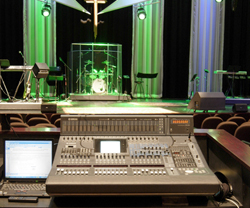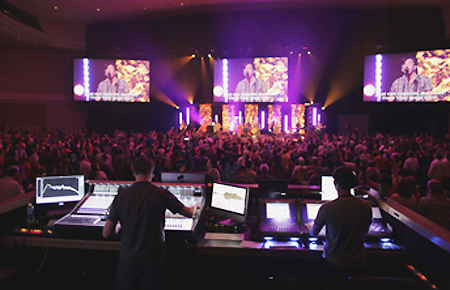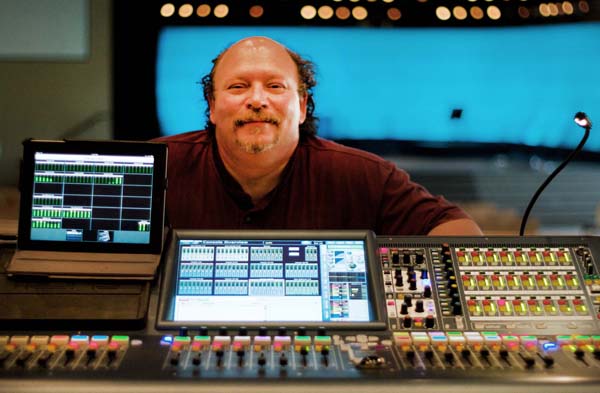
James River Assembly (JRA)
Springfield, MO
JRA became among the first venues in the U.S. to take delivery of a DiGiCo SD5, making it the new front of house console for the main campus of the 12,000-member church, joined by a new SD10 console for monitors. (Another SD5 console was also added as the house console for the church’s west campus.)
“When the previous system was designed, the church was doing a classic contemporary musical style, which included a choir and orchestra,” explains JRA audio director Stephen Maddox. “Since that time the church has transitioned musically to a rock/contemporary style of worship, but the old sound system wasn’t able to keep up with the output. The loudspeakers were the main culprit and got the conversation started for the revamp.”
Having consistency with the consoles at both campuses—running at 96 kHz—helped JRA achieve a streamlined sonic clarity as well. “It’s not like each venue is different,” Maddox says. “It’s the James River sound. Our tagline is ‘one church, two locations.’ We want the experience at either campus to be the same.” JRA technical engineer Brian Roggow also points to the flexibility of the platform. “The DiGiCos are very easy to understand and get around on. You can see a lot of information at a quick glance.
“I like the fact that they can easily be a multi-user, multitasking console. Part of that intuitiveness is being able to lay out the console like you want to, with either a musical or logical layout, for a specific part in our service; it’s very straightforward and easy to program.
“Some of the specific features I like are the floating inputs, allowing you to put anything where you want it,” he continues. “The virtual sound check is a huge performance boost allowing you to mix without people on stage.”
Life Center Foursquare Church, Spokane, WA
When it’s analog mixing console failed, the church saw an opportunity to improve both the sound quality and the workflow of the music presentation in it’s 1,800-seat sanctuary. Needing a replacement right away, the sound team flew to the Midas showroom and training center in Las Vegas to evaluate the PRO2 in person.
“Being a 24-bit, 96 kHz system, especially with the Midas preamps, the sound quality improvement was obvious,” states Dave Compogno (pictured here), front of house engineer for the church. “But the key was really the Mixtender app, which allowed us to replace our existing 16-bit monitor mixing system with iPads and bring that same sound quality to the musicians on stage.”
The church offers a powerful contemporary Christian music presentation, with a band consisting of electric and acoustic guitars, drums, bass, keyboards and three vocalists. Musicians now control their own monitor mixes via Mixtender. “It’s really nice because there’s a mix lock feature in the software so that each person controls just their own mix,” Compogno notes.“We found that, after the first time running it, everyone was perfectly comfortable managing their own in-ear mixes.”
The church controls both the house and monitor mixes from the PRO2, with the 64-in/24-out architecture affording all of the routing needed. At a typical service, there are eight in-ear monitoring mixes, five of which are sent via Shure PSM 900 wireless systems and three going to on-stage headphone amps.
“All of our mixes are in stereo, so I use all 16 sends off the DL251 stage box for monitor,” Compogno says. “That still leaves me plenty of room for sends to the house mix and video director. In fact, the video director is now doing his own mixes on an iPad as well.”


